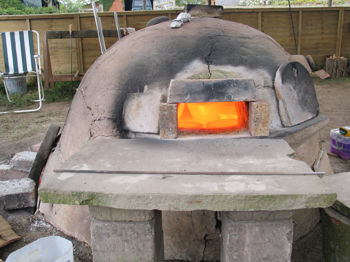

Introduction ('Home')
Glassworking Phase
General Photographs
Pot Furnace Photographs
Small Furnace Photographs
Lehr and Glass Photographs
Glassworking Photographs
The 2006 Project furnaces were lit on the morning of 1st May, at 11.30am, beginning a total of three weeks firing. Records of the progress of the project were kept along the same lines as those of the 2005 project, and included a site book as well as fuel consumption and temperature records. The furnaces were again stoked by a team of volunteers, many of them being veterans from the 2005 firing.


The pot furnace behaved as it had done in the 2005 firing – easy to fire and control, but the small furnace was more difficult to control and to maintain temperature, but in general, once over 1000°C it was easier to maintain it. This year, there were no pot failures as there had been in the previous year.
After two days of a gradual temperature rise in the pot furnace to allow the pots to heat up slowly, we filled the pots with cullet. Another twelve hours later we filled the pots in the small furnace. We took longer to heat the small furnace as the structure needed to be dried and fired.
The annealing oven performed very well, and it was possible to reheat from a residual temperature of about 80°C up to 520°C in one hour (we even have a record of it only taking 30 minutes). The initial firing was to 570°C in order to give it a chance to dry, but thereafter, to anneal the glass, the temperature was kept to around 520°C during the day.
The glass was once again based on Roman blue green glass compositions, with an added potful of a Venetian-style Cristallo in the small furnace. This was not a successful composition as it underwent devitrification during blowing, with successive reheats causing further devitrification. It is most likely due to an excess of alkali in the glass. See these photographs.
Fuel consumption was higher than in 2005:

The wood came from the same source, so once again we burned a mix of beech, ash, walnut, chestnut and yew. Total consumption compared with 2005 reflects heating the extra structure: the free-standing lehr, taking the pot furnace to higher temperatures for working ribbed bowls, and using the small furnace for glassworking, as well as experimenting with green wood.
In 2006 we produced many more vessels than we had in 2005 (see this page). We also experimented with making ribbed bowls and window panes.
"If you build it, they will come."